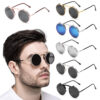Understanding Polarized Lenses
Polarized sunglasses incorporate a unique lens technology designed to enhance visual clarity and comfort. The fundamental difference between polarized lenses and regular sunglass lenses lies in their ability to filter out specific types of light. Regular sunglasses primarily reduce the overall brightness of light entering the eyes, offering minor relief from glare, but do not address its source. In contrast, polarized sunglasses contain a special chemical coating that aligns light waves vertically, significantly diminishing the intensity of horizontal glare.
To understand how polarized lenses work, it is essential to grasp the basics of light waves. Light travels in waves, and these waves can oscillate in various directions. When sunlight reflects off surfaces such as water, roads, or snow, it primarily reflects horizontally, resulting in pronounced glare. Polarized lenses are engineered to block this horizontally polarized light while allowing vertical light waves to pass through. This selective filtering reduces glare, enhancing visibility and reducing strain on the eyes, particularly in bright conditions.
Several types of polarized lenses are available on the market, each designed for specific activities or environments. For example, some polarized lenses are tailored for water sports, featuring coatings that repel water and resist scratches. Others are optimally designed for driving, enhancing contrast and reducing glare from wet roads. Various tints and lens materials are also available to cater to different lighting conditions, ensuring that users can find the ideal pair suited to their needs. The growing popularity of polarized sunglasses reflects their significant advantages in improving vision clarity, particularly in situations where glare is prevalent.
The Importance of UV Protection
The protection of our eyes from ultraviolet (UV) rays is a paramount concern for maintaining long-term vision health. Prolonged exposure to UV radiation can lead to serious eye conditions, including cataracts, macular degeneration, and even skin cancer around the eyelids. Polarized sunglasses are specifically engineered to provide this essential UVA and UVB protection, making them a vital accessory for anyone who spends time outdoors.
UV rays are often invisible to the naked eye, and their impact can be cumulative over time. This means that even brief exposure can gradually damage the eyes, culminating in significant health issues. By wearing polarized sunglasses, individuals can significantly reduce their risk of developing these eye problems. The technology behind polarized lenses not only minimizes glare from reflective surfaces, such as water and roads, but also filters out harmful solar radiation. This dual action enhances both visual comfort and eye safety.
Moreover, the role of polarized sunglasses extends beyond mere aesthetics or fashion statements; they serve as a practical investment in one’s eye care regime. The lenses are designed to block harmful rays effectively, which can help maintain the integrity of the retina and lens over the years. Additionally, with features such as anti-reflective coatings, these sunglasses further enhance clarity and reduce eye strain in bright conditions, facilitating better vision during activities like driving, fishing, or outdoor sports.
In conclusion, the importance of UV protection provided by polarized sunglasses cannot be overstated. Incorporating these protective eyewear options into everyday routines is a proactive step towards preserving eyesight and ensuring a healthier future for your vision.
Benefits of Reducing Glare
Glare is a significant impediment to clear vision, particularly in bright environments where sunlight reflects off surfaces such as water, roads, or snow. Polarized sunglasses have become a preferred choice for many due to their ability to dramatically reduce this disruptive glare. These specialized lenses contain a filter that blocks certain light waves while allowing others to pass through, effectively enhancing the wearer’s visual comfort and safety.
In scenarios like driving, reduced glare can be critical. Sunlight reflecting off the windshield or road can impair visibility, leading to potential hazards. Many individuals who have opted for polarized sunglasses while driving report a marked improvement in clarity, enabling them to detect obstacles, road signs, and vehicles more easily. A cyclist who switched to polarized lenses noted, “I could see the potholes much better, which allowed me to navigate more safely, especially on sunny days.” This improved visibility can contribute to safer driving experiences and enhanced confidence behind the wheel.
Moreover, outdoor enthusiasts, such as fishermen, benefit immensely from polarized sunglasses. Glare on the water can obscure fish, making it challenging to catch them. A fisherman shared that since using polarized lenses, he has not only caught more fish but also enjoyed the experience more, as he could see underwater structures and fish more clearly. The reduction in glare alleviates eye strain, allowing for prolonged periods of visibility without discomfort.
Engaging in outdoor sports, like skiing or snowboarding, also presents glare challenges. Polarized sunglasses offer significant advantages by enhancing visual clarity on icy slopes, allowing athletes to maintain their stability and awareness. Overall, polarized sunglasses serve as a crucial accessory, offering substantial benefits related to glare reduction, ensuring improved vision and safety in various activities.
Choosing the Right Polarized Sunglasses
Selecting the appropriate polarized sunglasses can significantly enhance your vision while providing protection against harmful UV rays. Understanding various features and options available in the market is crucial for finding a pair that meets your individual requirements and preferences.
One of the primary factors to consider is lens color. Different shades of polarized lenses not only impact style but also influence how much light is filtered. Grey lenses are often recommended for bright sunlight as they reduce glare while maintaining true color perception. Brown and amber lenses enhance contrast and depth perception, making them ideal for activities such as fishing or skiing, where clarity is essential. Meanwhile, yellow lenses can be beneficial in low light conditions, enhancing visibility.
Frame style is another important consideration. The design of the frames can affect both comfort and fit. Look for frames that are lightweight and adjustable to ensure a snug fit to the face, as this can prevent the sunglasses from slipping during physical activities. Full-rimmed frames offer durability and are suitable for everyday use, while semi-rimless or frameless options provide a sleek look and are often favored by athletes.
Additionally, evaluating the quality of polarized sunglasses is vital. Ensure that they provide 100% UV protection and are made from high-quality materials that resist scratches and impacts. When selecting sunglasses, check for labels indicating that the lenses have been tested for polarization. A reliable pair should blur reflections from surfaces such as water or roads, indicating effective glare reduction.
Furthermore, trying on polarized sunglasses whenever possible can help gauge the comfort level and fit. Preference for wider temples or wrap-around styles varies between individuals, thereby influencing overall satisfaction with the eyewear. A well-chosen pair of polarized sunglasses not only enhances vision but also becomes an essential accessory for protecting your eye health. By considering these key factors, you can make an informed decision that aligns with your lifestyle and personal taste.






